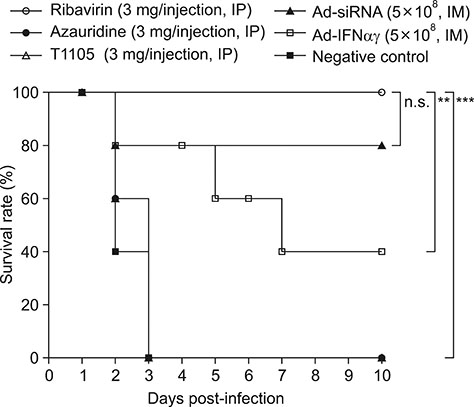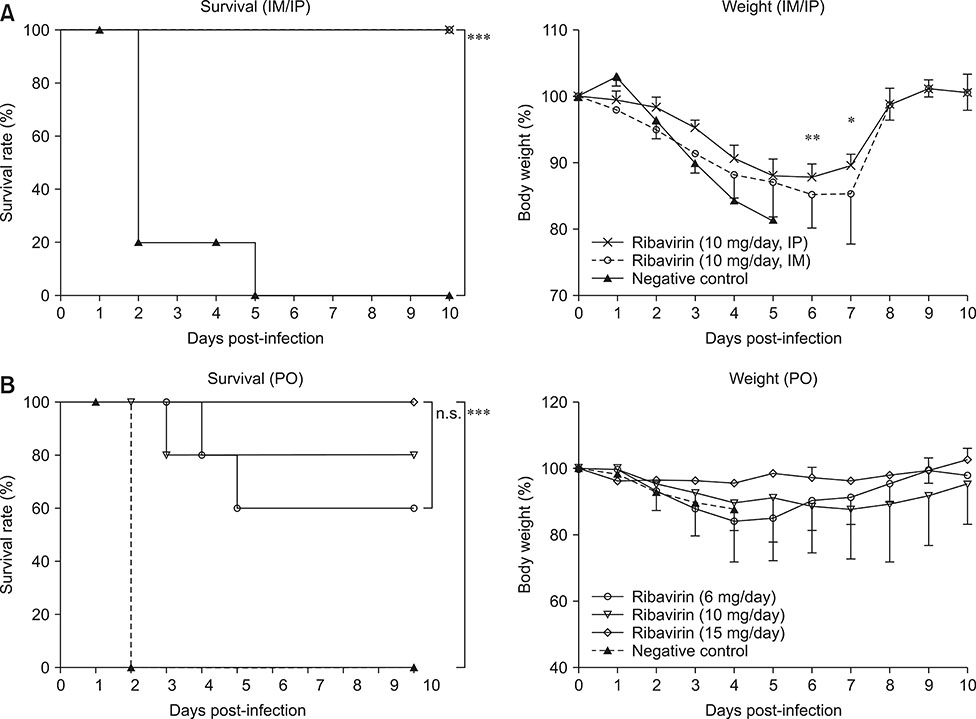J Vet Sci.
2018 Nov;19(6):788-797. 10.4142/jvs.2018.19.6.788.
Synergistic effect of ribavirin and vaccine for protection during early infection stage of foot-and-mouth disease
- Affiliations
-
- 1Animal and Plant Quarantine Agency, Gimcheon 39660, Korea. parkjhvet@korea.kr
- 2Bio-Center, Gyeonggi Business & Science Accelerator, Suwon 16229, Korea. medichem@gbsa.or.kr
- 3College of Veterinary Medicine, Konkuk University, Seoul 05029, Korea.
- KMID: 2427027
- DOI: http://doi.org/10.4142/jvs.2018.19.6.788
Abstract
- In many countries, vaccines are used for the prevention of foot-and-mouth disease (FMD). However, because there is no protection against FMD immediately after vaccination, research and development on antiviral agents is being conducted to induce protection until immunological competence is produced. This study tested whether well-known chemicals used as RNA virus treatment agents had inhibitory effects on FMD viruses (FMDVs) and demonstrated that ribavirin showed antiviral effects against FMDV in vitro/in vivo. In addition, it was observed that combining the administration of the antiviral agents orally and complementary therapy with vaccines synergistically enhanced antiviral activity and preserved the survival rate and body weight in the experimental animals. Antiviral agents mixed with an adjuvant were inoculated intramuscularly along with the vaccines, thereby inhibiting virus replication after injection and verifying that it was possible to induce early protection against viral infection prior to immunity being achieved through the vaccine. Finally, pigs treated with antiviral agents and vaccines showed no clinical signs and had low virus excretion. Based on these results, it is expected that this combined approach could be a therapeutic and preventive treatment for early protection against FMD.
Keyword
MeSH Terms
Figure
Reference
-
1. Airaksinen A, Pariente N, Menéndez-Arias L, Domingo E. Curing of foot-and-mouth disease virus from persistently infected cells by ribavirin involves enhanced mutagenesis. Virology. 2003; 311:339–349.
Article2. Alexandersen S, Donaldson AI. Further studies to quantify the dose of natural aerosols of foot-and-mouth disease virus for pigs. Epidemiol Infect. 2002; 128:313–323.
Article3. Alexandersen S, Zhang Z, Donaldson AI, Garland AJ. The pathogenesis and diagnosis of foot-and-mouth disease. J Comp Pathol. 2003; 129:1–36.
Article4. Belsham GJ. Distinctive features of foot-and-mouth disease virus, a member of the picornavirus family; aspects of virus protein synthesis, protein processing and structure. Prog Biophys Mol Biol. 1993; 60:241–260.
Article5. Chen W, Liu M, Jiao Y, Yan W, Wei X, Chen J, Fei L, Liu Y, Zuo X, Yang F, Lu Y, Zheng Z. Adenovirus-mediated RNA interference against foot-and-mouth disease virus infection both in vitro and in vivo. J Virol. 2006; 80:3559–3566.
Article6. Chinsangaram J, Moraes MP, Koster M, Grubman MJ. Novel viral disease control strategy: adenovirus expressing alpha interferon rapidly protects swine from foot-and-mouth disease. J Virol. 2003; 77:1621–1625.
Article7. Connor E, Morrison S, Lane J, Oleske J, Sonke RL, Connor J. Safety, tolerance, and pharmacokinetics of systemic ribavirin in children with human immunodeficiency virus infection. Antimicrob Agents Chemother. 1993; 37:532–539.
Article8. de Avila Botton S, Brum MC, Bautista E, Koster M, Weiblen R, Golde WT, Grubman MJ. Immunopotentiation of a foot-and-mouth disease virus subunit vaccine by interferon alpha. Vaccine. 2006; 24:3446–3456.
Article9. Durk RC, Singh K, Cornelison CA, Rai DK, Matzek KB, Leslie MD, Schafer E, Marchand B, Adedeji A, Michailidis E, Dorst CA, Moran J, Pautler C, Rodriguez LL, McIntosh MA, Rieder E, Sarafianos SG. Inhibitors of foot and mouth disease virus targeting a novel pocket of the RNA-dependent RNA polymerase. PLoS One. 2010; 5:e15049.
Article10. Golde WT, Pacheco JM, Duque H, Doel T, Penfold B, Ferman GS, Gregg DR, Rodriguez LL. Vaccination against foot-and-mouth disease virus confers complete clinical protection in 7 days and partial protection in 4 days: use in emergency outbreak response. Vaccine. 2005; 23:5775–5782.
Article11. González-Peralta RP, Kelly DA, Haber B, Molleston J, Murray KF, Jonas MM, Shelton M, Mieli-Vergani G, Lurie Y, Martin S, Lang T, Baczkowski A, Geffner M, Gupta S, Laughlin M;. Interferon alfa-2b in combination with ribavirin for the treatment of chronic hepatitis C in children: efficacy, safety, and pharmacokinetics. Hepatology. 2005; 42:1010–1018.
Article12. Grubman MJ. Development of novel strategies to control foot-and-mouth disease: marker vaccines and antivirals. Biologicals. 2005; 33:227–234.
Article13. Kamstrup S, Frimann TH, Barfoed AM. Protection of Balb/c mice against infection with FMDV by immunostimulation with CpG oligonucleotides. Antiviral Res. 2006; 72:42–48.
Article14. Kim SM, Kim SK, Park JH, Lee KN, Ko YJ, Lee HS, Seo MG, Shin YK, Kim B. A recombinant adenovirus bicistronically expressing porcine interferon-α and interferon-γ enhances antiviral effects against foot-and-mouth disease virus. Antiviral Res. 2014; 104:52–58.
Article15. Kim SM, Park JH, Lee KN, Kim SK, You SH, Kim T, Tark D, Lee HS, Seo MG, Kim B. Robust protection against highly virulent foot-and-mouth disease virus in swine by combination treatment with recombinant adenoviruses expressing porcine alpha and gamma interferons and multiple small interfering RNAs. J Virol. 2015; 89:8267–8279.
Article16. Knowles NJ, Samuel AR. Molecular epidemiology of foot-and-mouth disease virus. Virus Res. 2003; 91:65–80.
Article17. Lee DU, Je SH, Yoo SJ, Kwon T, Shin JY, Byun JJ, Park JH, Jeong KW, Ku JM, Lyoo YS. Hematological adverse effects and pharmacokinetics of ribavirin in pigs following intramuscular administration. J Vet Pharmacol Ther. 2017; 40:561–568.
Article18. Lertora JJ, Rege AB, Lacour JT, Ferencz N, George WJ, VanDyke RB, Agrawal KC, Hyslop NE Jr. Pharmacokinetics and long-term tolerance to ribavirin in asymptomatic patients infected with human immunodeficiency virus. Clin Pharmacol Ther. 1991; 50:442–449.
Article19. Moraes MP, Chinsangaram J, Brum MC, Grubman MJ. Immediate protection of swine from foot-and-mouth disease: a combination of adenoviruses expressing interferon alpha and a foot-and-mouth disease virus subunit vaccine. Vaccine. 2003; 22:268–279.
Article20. Moraes MP, de Los Santos T, Koster M, Turecek T, Wang H, Andreyev VG, Grubman MJ. Enhanced antiviral activity against foot-and-mouth disease virus by a combination of type I and II porcine interferons. J Virol. 2007; 81:7124–7135.
Article21. Mort M, Convey I, Baxter J, Bailey C. Animal disease and human trauma: the psychosocial implications of the 2001 UK foot and mouth disease disaster. J Appl Anim Welf Sci. 2008; 11:133–148.
Article22. Nettleton PF, Davies MJ, Rweyemamu MM. Guanidine and heat sensitivity of foot-and-mouth disease virus (FMDV) strains. J Hyg (Lond). 1982; 89:129–138.
Article23. Paarlberg PL, Lee JG, Seitzinger AH. Potential revenue impact of an outbreak of foot-and-mouth disease in the United States. J Am Vet Med Assoc. 2002; 220:988–992.
Article24. Park JN, Ko MK, Kim RH, Park ME, Lee SY, Yoon JE, Choi JH, You SH, Park JW, Lee KN, Chun JE, Kim SM, Tark D, Lee HS, Ko YJ, Kim B, Lee MH, Park JH. Construction of stabilized and tagged foot-and-mouth disease virus. J Virol Methods. 2016; 237:187–191.
Article25. Perales C, Agudo R, Domingo E. Counteracting quasispecies adaptability: extinction of a ribavirin-resistant virus mutant by an alternative mutagenic treatment. PLoS One. 2009; 4:e5554.
Article26. Quan M, Murphy CM, Zhang Z, Alexandersen S. Determinants of early foot-and-mouth disease virus dynamics in pigs. J Comp Pathol. 2004; 131:294–307.
Article27. Rada B, Dragún M. Antiviral action and selectivity of 6-azauridine. Ann N Y Acad Sci. 1977; 284:410–417.
Article28. Richmond JY, Hamilton LD. Foot-and-mouth disease virus inhibition induced in mice by synthetic double-stranded RNA (polyriboinosinic and polyribocytidylic acids). Proc Natl Acad Sci U S A. 1969; 64:81–86.
Article29. Sainz B Jr, Halford WP. Alpha/Beta interferon and gamma interferon synergize to inhibit the replication of herpes simplex virus type 1. J Virol. 2002; 76:11541–11550.
Article30. Salazar M, Yun NE, Poussard AL, Smith JN, Smith JK, Kolokoltsova OA, Patterson MJ, Linde J, Paessler S. Effect of ribavirin on junin virus infection in guinea pigs. Zoonoses Public Health. 2012; 59:278–285.
Article31. Vollmer J. Progress in drug development of immunostimulatory CpG oligodeoxynucleotide ligands for TLR9. Expert Opin Biol Ther. 2005; 5:673–682.
Article32. Vollstedt S, Arnold S, Schwerdel C, Franchini M, Alber G, Di Santo JP, Ackermann M, Suter M. Interplay between alpha/beta and gamma interferons with B, T, and natural killer cells in the defense against herpes simplex virus type 1. J Virol. 2004; 78:3846–3850.
Article33. Zeng J, Wang H, Xie X, Li C, Zhou G, Yang D, Yu L. Ribavirin-resistant variants of foot-and-mouth disease virus: the effect of restricted quasispecies diversity on viral virulence. J Virol. 2014; 88:4008–4020.
Article
- Full Text Links
- Actions
-
Cited
- CITED
-
- Close
- Share
- Similar articles
-
- QS-21 enhances the early antibody response to oil adjuvant foot-and-mouth disease vaccine in cattle
- Influence of vaccine potency and booster administration of foot-and-mouth disease vaccines on the antibody response in calves with maternal antibodies
- Effect of simultaneous administration of foot-and-mouth disease (FMD) and anthrax vaccines on antibody response to FMD in sheep
- Hand, Foot, and Mouth Disease: Clinical and Virological Investigations
- New foot-and-mouth disease vaccine, O JC-R, induce complete protection to pigs against SEA topotype viruses occurred in South Korea, 2014–2015





